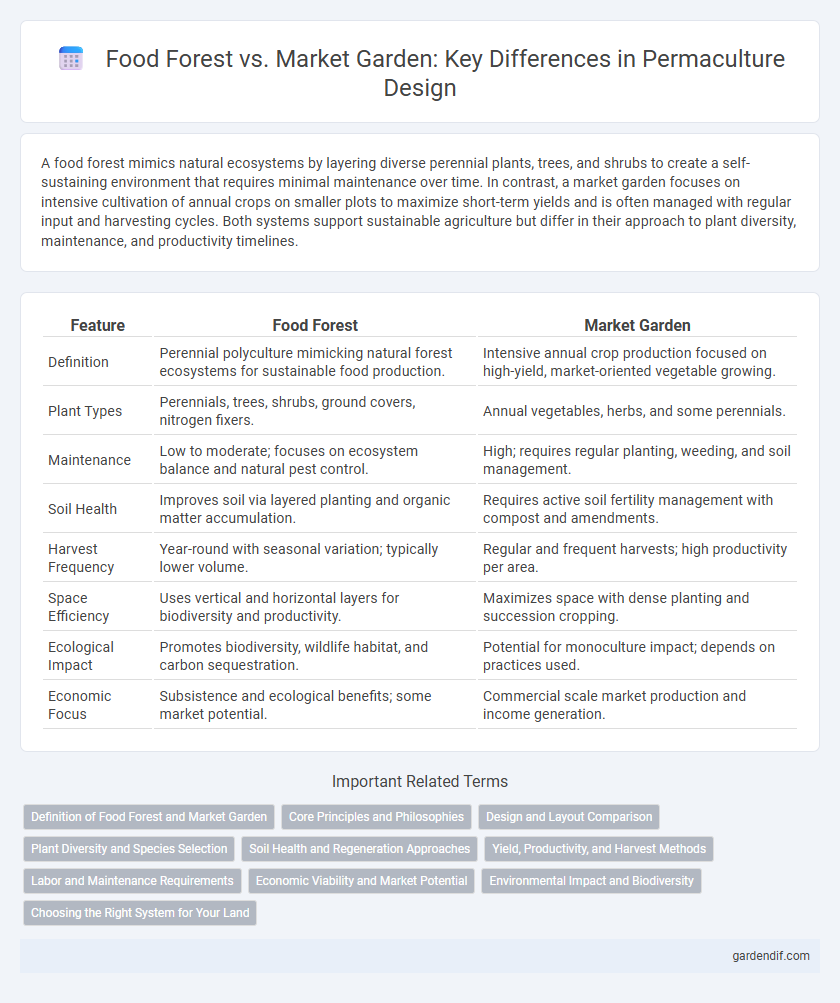
Food Forest vs Market Garden Illustration
A food forest mimics natural ecosystems by layering diverse perennial plants, trees, and shrubs to create a self-sustaining environment that requires minimal maintenance over time. In contrast, a market garden focuses on intensive cultivation of annual crops on smaller plots to maximize short-term yields and is often managed with regular input and harvesting cycles. Both systems support sustainable agriculture but differ in their approach to plant diversity, maintenance, and productivity timelines.
Table of Comparison
| Feature | Food Forest | Market Garden |
|---|---|---|
| Definition | Perennial polyculture mimicking natural forest ecosystems for sustainable food production. | Intensive annual crop production focused on high-yield, market-oriented vegetable growing. |
| Plant Types | Perennials, trees, shrubs, ground covers, nitrogen fixers. | Annual vegetables, herbs, and some perennials. |
| Maintenance | Low to moderate; focuses on ecosystem balance and natural pest control. | High; requires regular planting, weeding, and soil management. |
| Soil Health | Improves soil via layered planting and organic matter accumulation. | Requires active soil fertility management with compost and amendments. |
| Harvest Frequency | Year-round with seasonal variation; typically lower volume. | Regular and frequent harvests; high productivity per area. |
| Space Efficiency | Uses vertical and horizontal layers for biodiversity and productivity. | Maximizes space with dense planting and succession cropping. |
| Ecological Impact | Promotes biodiversity, wildlife habitat, and carbon sequestration. | Potential for monoculture impact; depends on practices used. |
| Economic Focus | Subsistence and ecological benefits; some market potential. | Commercial scale market production and income generation. |
Definition of Food Forest and Market Garden
A food forest is a diverse, multi-layered planting system designed to mimic a natural forest ecosystem, incorporating trees, shrubs, perennials, and ground covers to create a self-sustaining habitat that produces food. A market garden is a small-scale, intensive vegetable production system focused on high-yield, quick-turnover crops grown in rows or beds for direct sale to consumers. Food forests prioritize biodiversity and long-term resilience, while market gardens emphasize productivity and fast crop cycles.
Core Principles and Philosophies
Food forests emphasize mimicking natural ecosystems through diverse, perennial plant layers that improve soil health, water retention, and biodiversity. Market gardens prioritize intensive annual crop production with high yields using regenerative practices like crop rotation and cover cropping to maintain soil fertility. Both systems integrate permaculture principles but differ in scale, plant selection, and long-term sustainability focus.
Design and Layout Comparison
Food forests utilize multi-layered, perennial plant designs that mimic natural ecosystems, maximizing biodiversity and resilience with minimal inputs. Market gardens emphasize intensive, annual crop production in neatly arranged rows or beds for optimized space efficiency and easy access to crops. The contrasting layouts--food forests' complex vertical structure versus market gardens' orderly horizontal rows--reflect distinct goals of sustainability versus productivity.
Plant Diversity and Species Selection
Food forests prioritize high plant diversity with multiple layers of perennial species such as fruit trees, shrubs, herbs, and ground covers, creating a resilient ecosystem that mimics natural forests. Market gardens focus on selected annual and biennial crop species optimized for intensive production and fast turnover, often prioritizing uniformity and yield over diversity. Species selection in food forests emphasizes ecological functions like nitrogen fixation and pest control, while market gardens prioritize market-demanded crops and rapid growth cycles.
Soil Health and Regeneration Approaches
Food forests prioritize diverse layers of perennial plants and nitrogen-fixing species to build rich, living soil that enhances long-term regeneration through natural nutrient cycling. Market gardens often use intensive annual cropping with organic amendments and cover crops to maintain soil fertility and prevent erosion. Both systems promote soil health but differ in approach: food forests focus on mimicking natural ecosystems, while market gardens emphasize renewable inputs and crop rotation for continuous productivity.
Yield, Productivity, and Harvest Methods
Food forests typically yield a diverse range of perennial crops with lower annual productivity but higher resilience and soil health benefits, utilizing multi-layered, self-sustaining harvest methods. Market gardens focus on intensive cultivation of annual vegetables and herbs, maximizing short-term yield and productivity through row planting, frequent harvesting, and soil amendment. Harvest methods in food forests are often selective and seasonal, while market gardens rely on continuous, systematic crop rotations and frequent harvest cycles to maintain high output.
Labor and Maintenance Requirements
Food forests require lower ongoing labor and maintenance by mimicking natural ecosystems with perennial plants that establish over time, reducing the need for frequent tilling, watering, and planting. Market gardens demand higher labor inputs due to intensive annual crop cycles, regular soil preparation, pest management, and harvesting schedules. Efficient labor allocation in permaculture depends on balancing the low-maintenance, self-sustaining aspects of food forests with the high-input productivity of market gardens.
Economic Viability and Market Potential
Food forests offer long-term economic viability through perennial crops that require low inputs and provide diverse yields year-round, appealing to niche markets seeking sustainable and organic produce. Market gardens generate higher short-term profits by producing fast-growing annual vegetables with intensive planting, catering to local fresh produce demands and restaurant supply chains. Both systems present distinct market potentials: food forests capitalize on resilience and ecosystem services, while market gardens excel in rapid turnover and scalability for urban consumers.
Environmental Impact and Biodiversity
Food forests enhance environmental impact by mimicking natural ecosystems, promoting soil health, water retention, and carbon sequestration, while supporting high biodiversity through layered plant species and diverse habitats. Market gardens typically focus on intensive, annual crop production with lower biodiversity and greater reliance on soil inputs, potentially leading to soil degradation and reduced ecosystem services. Integrating permaculture principles, food forests offer a sustainable alternative that fosters resilience and ecological balance compared to conventional market garden practices.
Choosing the Right System for Your Land
Choosing between a food forest and a market garden depends on land size, soil health, and maintenance capacity. Food forests emphasize perennial plants and biodiversity, offering long-term sustainability with minimal input, ideal for larger, ecologically diverse spaces. Market gardens prioritize annual crops, intensive cultivation, and rapid yields, suited for smaller plots and high-production goals.
Food Forest vs Market Garden Infographic

 gardendif.com
gardendif.com